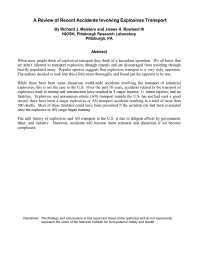Mining Publication: A Review of Recent Accidents Involving Explosives Transport
Original creation date: March 2009
Explosions and ammonium nitrate (AN) transport in the U.S. is very safe. Unfortunately the same cannot be said of explosive and AN transport in all parts of the world. The safe history of explosives and AN transport in the U.S. is due to diligent efforts by government, labor, and industry. However, accidents will become more common and disastrous if we become complacent. Most of the incidents described above involved AN and there was a delay between the time the accident occurred, the cargo caught fire, and the cargo exploded. There is a potential to significantly reduce injuries and fatalities if the time between the fire and explosion were used for evacuation rather than fighting the fire.
Authors: RJ Mainiero, JH Rowland
Peer Reviewed Journal Article - March 2009
NIOSHTIC2 Number: 20035407
J Explos Eng 2009 Mar; 26(2):6-12
See Also
- Blasting and Explosives
- Determining the Root Causes of Flame Cutting and Welding Fires in Underground U.S. Coal Mines
- Evaluation of the Bagged Stone Dust Barrier Effectiveness in a Bord and Pillar Mine
- Explosion Temperatures and Pressures of Metals and Other Elemental Dust Clouds
- Initial Study of Buried Communication Cable for Underground Mines
- Methane Control in United States Coal Mines - 1972
- Rapid (Grab) Sampling During Full-scale Explosions - Microscopic and Analytical Evaluation
- Refuge Chamber Expectations Training - 1.0
- Remotely Installed Mine Seals for Mine Fire Control
- The Role of ASTM E27 Methods in Hazard Assessment: Part II - Flammability and Ignitability
- U.S. Bureau of Mines Technology Applicable to Disaster Response, Urban Search And Rescue
- Content source: National Institute for Occupational Safety and Health, Mining Program


 ShareCompartir
ShareCompartir
